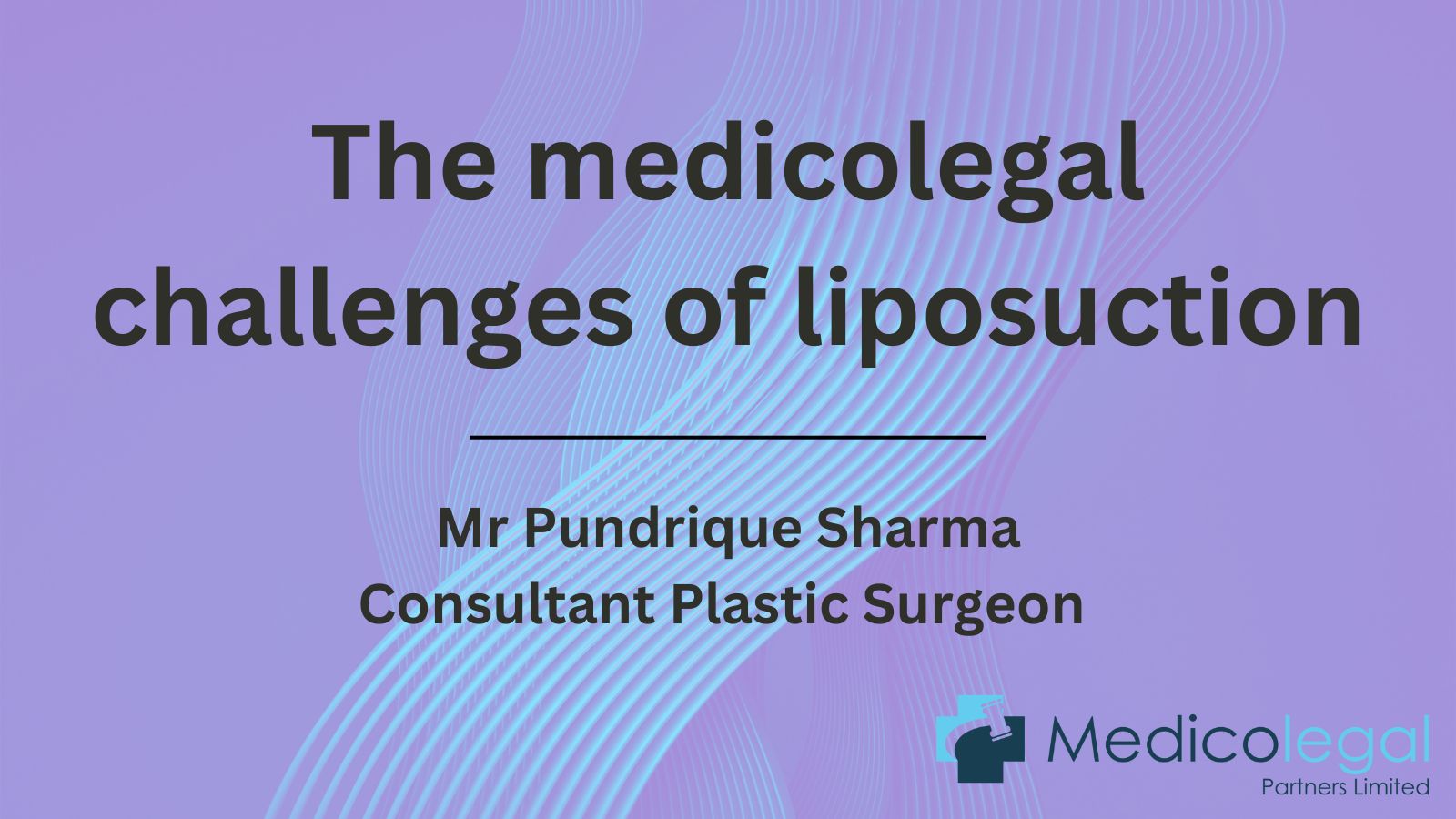The medicolegal challenges of liposuction

Suction-assisted lipectomy, otherwise known as liposuction, is a procedure in which adipose tissue is removed from subcutaneous spaces through a cannula, with the aim of achieving a more desirable body contour. The popularity of the procedure has increased hugely over the past two decades and it is now one of the most common surgical procedures performed worldwide. When correctly carried out, liposuction allows plastic surgeons to remove or redistribute body fat in accordance with the patient’s ideal. As well as aesthetic uses, liposuction can also be an important adjunct to reconstructive surgery following disease or injury.
Compared with other surgical procedures, liposuction is often minimally invasive and generally carries a low risk of complications. When combined with other surgeries, the rate is around 3.5%, but it can be as low as 0.7% when performed as a solitary procedure. For this reason, it is often perceived to be a relatively safe procedure. However, although complications, which include oedema, surgical site infection, seroma, haematoma and venous thromboembolism, are rare, when they occur, they can have serious consequences.
The most common complication following liposuction is contour deformity, which can take the form of soft-tissue depressions or elevations, skin folds or wrinkles, or fat necrosis, a subcutaneous deposit of hard, non-viable fatty material. The risk of contour deformities is increased if suctioning is performed in one of the five areas of the body where the superficial subcutaneous tissues adhere to underlying deep muscle fascia. This is because these zones define the natural body shape. The choice of incision site is also important. Ideally, it should be located where the resulting scar can be relatively hidden as well as being in a location that allows broad fanning of the cannula during the procedure.
Haematomas, blood clots and seromas can all occur following liposuction. Untreated haematomas and blood clots can lead to skin necrosis, infections and excessive scarring and if they occur in the neck region, there is also the potential for airway obstruction. It is therefore vital that any complications of this nature are identified quickly so that they can be treated in a timely manner. Seromas, collections of serous fluid resulting from breakdown of the fibrous tissue network, may develop from an initial cannula injury to small perforating vessels or lymphatic vessels, and the higher the volume of fat removed, the greater the risk of seroma development.
High-volume fat transfer is also associated with a higher risk of infection at the graft site. Although wound infections only occur in around 1% of outpatient procedures, they can develop into more serious conditions such as sepsis or necrotising fasciitis, both of which are medical emergencies and can have devastating consequences for the patient. Proper sterilisation of surgical sites, careful technique and the use of prophylactic antibiotics can all help to reduce the risk of infection.
Fat embolism is a rare complication, but one which can be fatal. It can develop following injury to gluteal veins and has a mortality rate of around 10–15%. As it normally occurs within 12 to 72 hours after surgery, careful postoperative monitoring of the patient should enable rapid detection and treatment. The risk of venous thromboembolic events, such as deep venous thrombosis and pulmonary embolism, can be reduced by, for example, encouraging the patient to remain mobile after surgery.
Some complications may take days, weeks or even months to manifest. These include oedema, lymphoedema, wound breakdown, hypertrophic scar formation, bruising and skin discolouration, and skin laxity. Bowel perforation or injuries to vessels or the abdominal wall may result from cannula misplacement. Skin devascularization and necrosis can also occur if suctioning is performed too close to the skin’s surface and the sub-dermal plexus is damaged. Therefore, patient follow-up is important in identifying any of these issues.
In order to reduce the risk of complications, patient selection is vital. Although there are no absolute contraindications for liposuction, some comorbidities may increase the risk of complications. In particular, patients with diabetes, or liver or cardiac disease, should be carefully evaluated as these conditions, if poorly controlled, increase the risk of infection. The best results from liposuction are achieved in patients who are within range of their ideal body weight and have specific “stubborn” areas, and who retain adequate skin elasticity. In elderly patients, low skin elasticity can result in poor postoperative skin draping and potential patient dissatisfaction. It is also important that the patient understands that weight control, combined with physical exercise, over the long term will achieve the best results. Finally, the patient’s motivation for seeking liposuction should be explored, so that unrealistic expectations can be managed. Patients with body dysmorphia can be especially problematic in this respect and must be identified before surgery.
Patients undergoing liposuction generally have relatively short recovery times, unobtrusive scars and low complication rates. Because the procedure removes adipose cells, the future development of fat in treated areas is limited; thus, the results are long-lasting and patient satisfaction is high. Although complications are rare, they can be serious and potentially disfiguring. Therefore, good anatomical knowledge, correct surgical technique, scrupulous hygiene and rapid management of complications are all essential to prevent a potential claim.
Further reading:
Diniz, D. A., Gonçalves, K. K., Silva, C. C., Araújo, E. S., Carneiro, S. C., Lago, C. A., & Vasconcelos, B. C. (2022). Complications associated with submental liposuction: a scoping review. Medicina oral, patologia oral y cirugia bucal, 27(3), e257–e264. https://doi.org/10.4317/medoral.25122
Wu, S., Coombs, D. M., & Gurunian, R. (2020). Liposuction: Concepts, safety, and techniques in body-contouring surgery. Cleveland Clinic Journal of Medicine, 87(6), 367–375. https://doi.org/10.3949/ccjm.87a.19097




